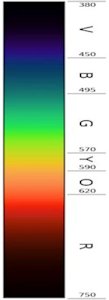
|
Distinction of Blue and Green in Various Languages
Many languages do not have separate terms for blue and green, instead using a
cover term for both (when the issue is discussed in linguistics, this cover
term is sometimes called grue in English). For example, in Vietnamese both tree
leaves and the sky are xanh (to distinguish, one may use xanh lá cây
"leaf
grue" for green and "ocean grue" for blue). In the Thai language,
(khiaw) means green except when referring to the sky or the sea, when it means
blue; (khiaw cha-um), (khiaw khachi), and (khiaw praed) have all meant either
intense blue or garish green, although the latter is becoming more usual as the
language 'learns' to distinguish blue and green. Chinese has a word (qing)
that can refer to both, and sometimes black, though it also has separate words
for blue (lán), green (lu`), and black ( hei). The Korean word (pureuda)
can mean either green or blue. In Japanese, the word for blue (ao) is often
used for colors that English speakers would refer to as green, such as the
color of a traffic signal meaning "go." Many Bantu languages utilize the same
word for blue and green.
Return to Web Color Choices
French, as most Romance languages, makes roughly the same distinctions as English and has a specific term for blue ("bleu"), green ("vert") and grey ("gris"). For all three, different shades can be indicated with different (compound) terms, none of them being considered as basic color terms: "bleu clair" (light blue), "bleu ciel" (sky blue), "bleu marine" (Navy blue), "bleu roi" (royal blue); "vert clair" (light green), "vert pomme" (literally: apple green); "gris anthracite" (very dark grey), "gris souris" (literally: mouse grey). |
| Linear visible spectrum |